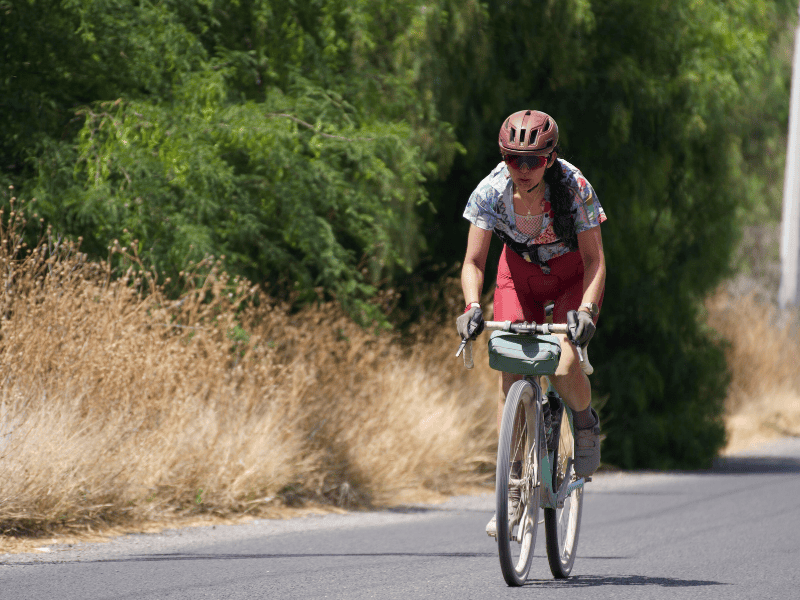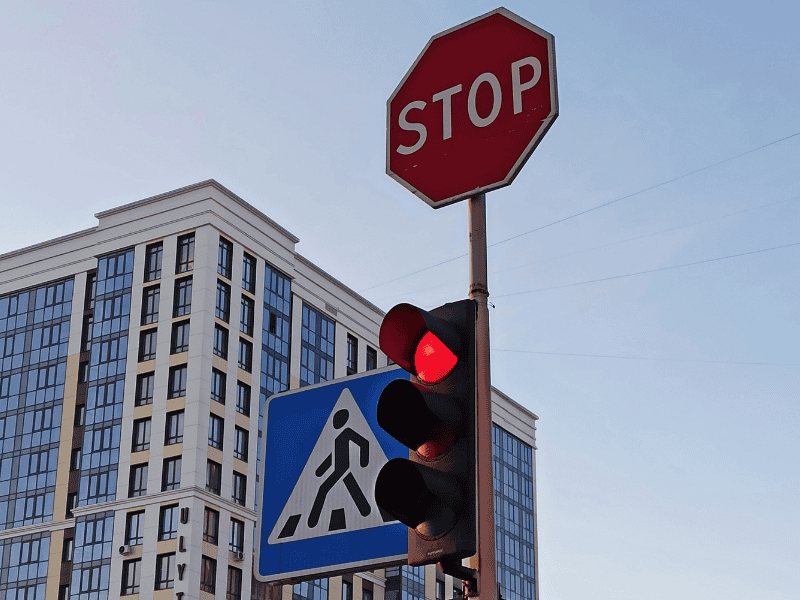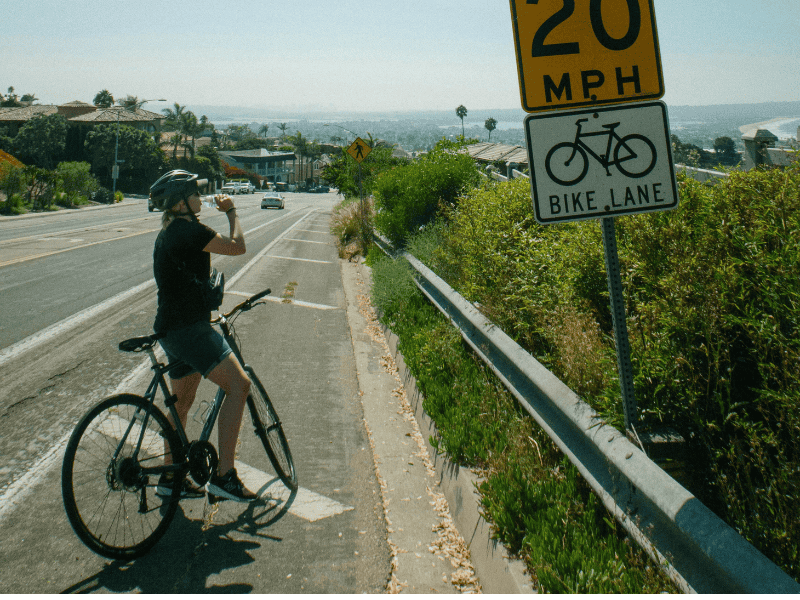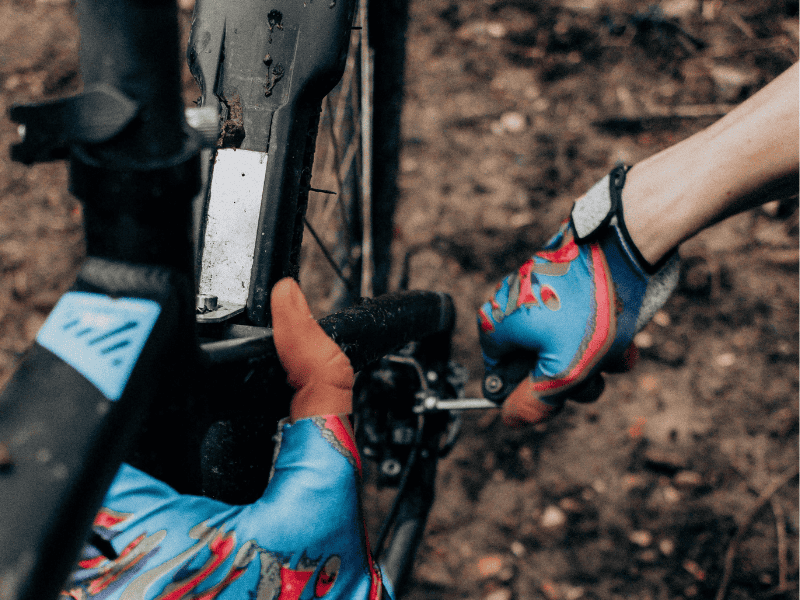
There’s nothing like the joy of pedaling through life on two wheels. But with great freedom comes great responsibility, right?
That’s why today, we’re diving into the essential rules of the road for cyclists to keep you safe and ensure every ride is a delight.
Let’s get started.

Whether you’re a runner looking for running tips or a cyclist searching for cycling advice, this site is here to help you elevate your fitness game.
The 9 Rules of the Road for Cyclists
Rule 1: Always Wear a Helmet

Your safety on the road is non-negotiable, and a helmet is one of your best defenses against serious injury.
Research supports this: According to a study by Jake Olivier and Prudence Creighton published in the International Journal of Epidemiology in 2017, titled ‘Bicycle injuries and helmet use: A systematic review and meta-analysis,‘ wearing a helmet significantly reduces the risk of head injuries for cyclists.
Here’s what wearing a helmet can do for you:
Now not all helmets are the same, so here’s how you can find one that’s right for you:
Is it illegal to ride a bike without a helmet?
If you’re wondering, ‘Is it illegal to ride a bike without a helmet’? The answer is that it varies by location. Helmet laws can differ widely between states and countries.
So before you hit the road, it’s a good idea to check the laws in your area. Many places require helmets for cyclists, especially for minors.
Resources:
- US: You can find info on state-specific helmet laws on The League of American Bicyclists page.
- UK: You’ll find cyclists rules on the Department for Transport’s The Highway Code page.
But even if it’s not required by law in your area, it’s always a smart choice for safety.
Rule 2: Follow Traffic Signals and Signs

Yes, cyclists must obey the same traffic laws as vehicles. This means stopping at red lights and stop signs, yielding to pedestrians, and following traffic signs.
Why’s this so important, you ask?
Safety first: These laws are all about making sure everyone on the road, whether on two wheels or four, stays safe and sound.
When cyclists and drivers stick to the rules, traffic becomes predictable and smooth on the road, cutting down confusion, helping traffic flow better, and keeping roads safer for everyone.
Do cyclists have to stop at stop signs?
Absolutely! Just like cars, bicycles must stop at stop signs to prevent accidents and keep everyone safe at intersections.
Is it legal to ride a bike on the highway?
In most places, bicycles aren’t allowed on highways, but there are exceptions where it’s allowed if there’s no other route available. It’s wise to check local laws to stay safe and avoid fines
Rule 3: Use Hand Signals
Communication is vital, especially on the road because it keeps you safe. Using hand signals to show when you’re turning or stopping is crucial because it helps drivers and other cyclists know what you’re going to do.
Here are some hand signals you can use while riding:
Rule 4: Ride in the Direction of Traffic

Riding against traffic might seem like a good idea, but it’s a big no-no.
Always ride in the same direction as traffic because this makes it easier for drivers to see you and lowers the chance of a crash. When you ride with traffic, drivers can predict what you’ll do, making it safer for everyone.
Always remember, being predictable keeps you safe on the road.
But if you’re nervous about riding in traffic, consider exploring bike-only trails. This post provides the resources you need to find the ideal bike trail for you.
Rule 5: Stay Visible
Visibility is vital, especially during early mornings, evenings, and when you’re cycling in the rain.
Let’s talk about how to stay visible when you’re cycling on the road.
- Wear bright or reflective gear. Reflective bands (like these) reflect light from vehicles, making you noticeable on the road. For maximum visibility and safety, wear the bands on the parts of your body that move the most (your ankles and knees) because movement attracts attention.
- Install a bike headlight. A bike headlight (like this rechargeable one) signals your presence to other vehicles, helps you see in low-light conditions, and can reduce your probability of getting into a bike accident. 2
- Choose a flashing rear bike light instead of a steady one to make you stand out up to 2.4 times more than a rider with no lights and up to 1.4 times more than someone using only a steady light. 3
Affiliate Disclosure: I’m here to help you grow as a rider and runner. So to keep things running smoothly and the content free, I participate in the Amazon Services program and select affiliate networks. So, when you click on those affiliate links, I earn a small commission at no extra cost to you.
Garmin Varia RTL515 Rearview Radar with Taillight
- Stay Aware: Varia’s radar detects vehicles approaching from 140 meters behind, sending alerts to your Garmin Edge or smartphone.
- Navigate Safely: Gauge car distance with its clear display for timely lane adjustments.
- Be Seen: Visible up to a mile away, day or night, thanks to its powerful bulb.
- Long Battery Life: Up to 16 hours in flash mode ensures you’re covered for any ride.
- Cyclist-Friendly Features: Includes Peloton mode to dim lights and conserve battery.
Rule 6: Maintain Your Bike

Regular bike maintenance is key to a smooth and safe ride. Here’s what you should do:
Schedule professional tune-ups at least once a year (twice a year if you’re a frequent rider) to keep everything in top shape.
Crank Brothers Multi 17 Tool
Don’t let mechanical hiccups derail your ride. The Crankbrothers Multi 17 Tool is the Swiss Army knife of bike maintenance, packing 17 tools into one sleek, 3.5-inch package to fix anything from chain repairs to spoke adjustments.
✅ 17 precision tools in one compact device
✅ Durable steel bits for long-lasting performance
✅ Lightweight aluminum handle with a secure grip
✅ Everything you need for on-the-go repairs
Rule 7: Stay Alert and Aware of Your Environment
Visual Awareness
Keep your eyes on the road ahead and constantly scan for potential hazards.
Here’s what to look out for:
Always check intersections, even if you have the right of way, and be extra cautious in areas with limited visibility like curves and hills.
Auditory Awareness
Avoid using headphones or earbuds while cycling—they can mask important environmental sounds. You don’t want to miss approaching vehicles, emergency sirens, or warning shouts. If you must listen to music, consider using a single earbud or bone-conduction headphones.
Pay attention to the sounds around you:
Using Mirrors
Consider installing a bicycle mirror on your handlebars or helmet. Regularly check your mirror to stay aware of:
But don’t rely solely on mirrors; always perform shoulder checks before changing lanes or turning.
Rule 8: Watch Out for Pedestrians

Sharing the road means looking out for everyone, including pedestrians. Always yield to them at crosswalks and intersections.
On shared paths, give a friendly heads-up—such as an audible “on your left“—when you’re passing. And take it slow in crowded spots to ensure everyone’s safety.
Rule 9: Use Bike Lanes When Available
Bike lanes are your safety zones, so use them whenever you can. They create a buffer between you and cars and lower the risk of accidents.
Stay in the bike lane, but be careful of parked cars and doors that might open suddenly. If you need to leave the bike lane, signal what you’re going to do and be careful.
Bike lanes are designed to keep you safe—make the most of them!

